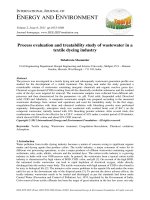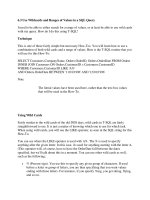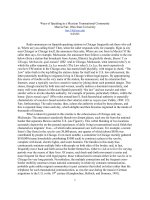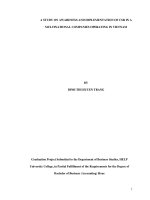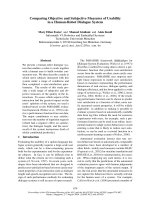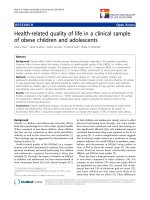Sorption, transformation and transport of sulfadiazine in a loess and a sandy soil
Bạn đang xem bản rút gọn của tài liệu. Xem và tải ngay bản đầy đủ của tài liệu tại đây (1.36 MB, 135 trang )
Institut f¨
ur Nutzpflanzenwissenschaften und Ressourcenschutz
Sorption, Transformation and
Transport of Sulfadiazine in a
loess and a sandy Soil
Genehmigte Inaugural-Dissertation
zur
Erlangung des Grades
Doktor der Agrarwissenschaften
(Dr. agr.)
der
Landwirtschaftlichen Fakult¨at
der
Rheinischen Friedrich-Wilhelms-Universit¨at Bonn
von
Dipl. Geo¨okol. Stephan Sittig
aus
Liebenburg
Referent:
Prof. Dr. Harry Vereecken
Koreferent:
Prof. Dr. Wulf Amelung
Tag der m¨
undlichen Pr¨
ufung:
06.06.2014
Erscheinungsjahr:
2014
Meinem Vater
Danksagungen
Ich bedanke mich bei allen Personen, die zum Zustandekommen
dieser Dissertation beigetragen haben. Namentlich sind dabei zu
nennen Roy Kasteel und Joost Groeneweg als direkte Betreuer
dieser Arbeit, deren Beitrag in Wort und Schrift diese Promotionsarbeit erm¨oglicht haben. Mein Doktorvater Harry Vereecken
brachte im direkten Gespr¨ach sowie in der Nachbearbeitung meiner
Vortr¨age im Rahmen des Doktorandenseminars immer wichtige
Impulse f¨
ur das Vorw¨artskommen. Herrn Wulf Amelung von der
¨
Universit¨at Bonn danke ich f¨
ur die Ubernahme
des Koreferendats.
Mein Gastaufenthalt bei Jasper Vrugt an der University of California in Irvine, USA brachte mich in vielerlei Hinsicht fachlich
und pers¨onlich weiter.
F¨
ur die Finanzierung des Promotionsvorhabens danke ich der Deutschen Forschungsgemeinschaft, namentlich organisiert in der Forschergruppe 566 ’Tierarzneimittel in B¨oden: Grundlagenforschung
f¨
ur eine Risikoanalyse’. Die Bereitstellung des radioaktiv markierten
Sulfadiazins sowie die Durchf¨
uhrung der F¨
utterungsversuche durch
BayerHealthCare bzw. BayerCropScience war f¨
ur die Durchf¨
uhrung
der Laborversuche essenziell.
W¨ahrend der Laborarbeiten war der fachliche und pers¨onliche
Austausch sehr inspirierend. Dabei bin ich vielen Leuten dankbar:
Stephan K¨oppchen, David Vonberg, Katharina Nobis, Max Gotta,
Wiebke Schulte-Hunsbeck sowie Ulrike Langen und Martina Krause.
Neben den fachlichen Diskussionen haben viele pers¨onliche Beziehungen die Zeit am Forschungszentrum zu einer sehr angenehmen
gemacht. Meiner Mutter und meinem w¨ahrend der Promotionszeit
verstorbenen Vater verdanke ich sehr viel f¨
ur den Zuspruch und
den R¨
uckhalt w¨ahrend des Universit¨atsstudium sowie w¨ahrend der
Zeit in J¨
ulich.
Abstract
Veterinary antibiotics are unintentionally introduced into the environment and therefore found in ground and surface water, soil and
sediments, air, plants etc. They enter these compartments mainly
via application of manure or sewage sludge to soils for fertilizing
purposes or after application in aquaculture, in form of the parent compound or a transformation product. Generally, sorption,
transformation and transport determines the fate of these organic
contaminants in soil. Their wide-spread distribution bears several
risks, i. e. spreading of resistance genes or occurrence in the food
chain.
Long-term (60 days) batch studies were conducted applying radiolabelled sulfadiazine to samples from two agricultural soils to investigate the sorption and sequestration behavior in the plow layers. Sequential extractions at several time-steps served to analyze
the dynamics of both processes. A numerical evaluation served
to describe instantaneous sorption, the dynamics of sorption and
sequestration, and the formation of non-extractable residues. Multiple extractions with the harsh method questioned the concept of
non-extractable residues, since with each consecutive extraction
step, further sulfadiazine could be extracted.
Analyzing the liquid phase and the extracts from these batch experiments with Radio-HPLC served to improve the understanding
of the transformation behavior in soils in different degrees of (bio)availability. Apart from the deduction of rate-parameters for a
compartment model, the resemblance of the compositions in the
liquid phases and the harsh extracts was demonstrated. The formation of the up to six transformation products showed distinct
dynamics, either spontaneous or with a time-lag.
Laboratory column experiments with multiple applications of sulfadiazine either together with manure from pig-feeding experiments or in liquid solution served to the improved understanding
of the transport processes and the transformation during trans-
port. A numerical description of the breakthrough curves elucidated the processes during movement through undisturbed soil.
The composition in the outflow was considerably different in terms
of transformation products, as a factor of application mode and
soil.
This thesis updated the knowledge of the environmental behavior
of sulfadiazine, since we investigated the fate in its most important
aspects of sorption, transformation and transport.
Zusammenfassung
Veterin¨arpharmaka werden unbeabsichtigt in die Umwelt eingef¨
uhrt
und sind demzufolge vorhanden in Grund- und Oberfl¨achenwasser,
Boden und Sedimenten, Luft, Pflanzen usw. Sie gelangen in diese
verschiedenen Kompartimente durch das Ausbringen von G¨
ulle
und Kl¨arschlamm auf landwirtschaftliche Felder zum Zwecke der
D¨
ungung oder durch den Einsatz in Aquakulturen, entweder unver¨andert oder in Form von Transformationsprodukten. Das Schicksal von organischen Kontaminanten wird generell bestimmt von
Sorption, Transformation und dem Transportverhalten. Die weitreichende Verteilung von Antibiotika aus der Tierhaltung birgt verschiedene Risiken, wie z. B. die Ausbreitung von Resistenzgenen
oder den ¨bergang in die menschliche Nahrungskette.
Langzeit-Sch¨
uttelversuche (60 Tage) mit radioaktiv markiertem
Sulfadiazin und Proben von zwei landwirtschaftlichen B¨oden wurden durchgef¨
uhrt mit dem Ziel das Sorptions- und Sequestrierungsverhalten in den beiden Pflughorizonten zu untersuchen. Sequenzielle Extraktion an den verschiedenen Zeitpunkten erlaubte die
Analyse der Dynamiken beider Prozesse. Eine numerische Auswertung diente der Beschreibung der instantanen Sequestrierung, dem
Verlauf der Sorption und der Bildung nicht-extrahierbarer R¨
uckst¨ande. Mehrfache harsche Extraktionen stellte das Konzept der
nicht-extrahierbaren R¨
uck-st¨ande grunds¨atzlich in Frage, da mit
jeder weiteren Extraktion immer mehr Substanz extrahiert werden konnte.
Die Analyse der Fl¨
ussigphase und der Extrakte aus diesen Versuchen mit Radio-HPLC zeigte das Transformationsverhalten in
verschiedenen Graden der (Bio-)verf¨
ugbarkeit. Neben der Ermittlung von Raten-parameter f¨
ur ein Kompartimentmodell wurde
die ¨ahnlichkeit von Fl¨
ussigphase und sorbierter Phase demonstriert. Die Formation der bis zu sechs Transformationsprodukte zeigt
deutlich unterschiedliche Dynamiken, sowohl spontan als auch mit
einer Zeitverz¨ogerung.
Labor-S¨aulenversuche mit Mehrfachapplikation von Sulfadiazin,
entweder in Form von G¨
ulle aus Futterexperimenten oder in w¨assriger L¨osung diente dem besseren Verst¨andnis der Transportprozesse
und der Transformation w¨ahrend der Transports. Eine numerische
Modellbeschreibung der Durchbruchskurven beleuchtete die Transportprozesse w¨ahrend des Durchbruchs durch ungest¨orte Bodens¨aulen. Die Zusammensetzung des Ausflusses war deutlich unterschiedlich in Hinsicht auf die Transformationsprodukte.
Insgesamt tragen die Ergebnisse der verschiedenen Studien in dieser
Dissertation zu einem besseren Verst¨andnis des Umweltverhaltens
von Sulfadiazin bei, da dessen Verhalten w¨ahrend der Prozesse der
Sorption, Transformation und dem Transport untersucht wurde.
Contents
Contents
i
List of Tables
v
1 Introduction
1.1 Rationale . . . . . . . . . . . . . . . . . . . . . . .
1.2 General objectives and outline of the thesis . . . .
1
1
5
2 Long-term sorption and sequestration dynamics of
the antibiotic sulfadiazine - a batch study
2.1 Introduction . . . . . . . . . . . . . . . . . . . . .
2.2 Materials and methods . . . . . . . . . . . . . . .
2.2.1 Laboratory experiments . . . . . . . . . . .
2.2.2 Modeling . . . . . . . . . . . . . . . . . . .
2.3 Results and discussion . . . . . . . . . . . . . . . .
2.3.1 Multiple extractions . . . . . . . . . . . . .
2.3.2 Long-term batch experiments: sterilized soil
2.3.3 Long-term batch experiments: untreated soils.
26
2.3.4 Effects of sterilization . . . . . . . . . . . .
2.3.5 2SIS description for the multiple extractions
2.4 Conclusions . . . . . . . . . . . . . . . . . . . . . .
i
7
7
10
10
14
19
19
21
27
28
29
3 Dynamics of transformation of the veterinary antibiotic sulfadiazine in two soils
3.1 Introduction . . . . . . . . . . . . . . . . . . . . .
3.2 Materials and Methods . . . . . . . . . . . . . . .
3.2.1 Chemicals . . . . . . . . . . . . . . . . . . .
3.2.2 Long-term batch experiments . . . . . . . .
3.2.3 Instrumentation and measurements . . . . .
3.2.4 Mathematical description of dissipation and
transformation in the liquid phase . . . . .
3.3 Results and discussion . . . . . . . . . . . . . . . .
3.3.1 Transformation products of SDZ . . . . . .
3.3.2 Transformation in the two soils . . . . . . .
3.4 Conclusions . . . . . . . . . . . . . . . . . . . . . .
3.5 Supplementary material . . . . . . . . . . . . . . .
3.5.1 Schedule of the laboratory experiments . .
3.5.2 Modeling the bi-phasic behavior of SDZ and
deriving additional endpoints . . . . . . . .
3.5.3 Schedule of the simulations . . . . . . . . .
3.5.4 Measurements at the end of the 60-day experimental period . . . . . . . . . . . . . .
3.5.5 Correlations between soil properties and sorption and transformation parameters . . . .
4 Transport of sulfadiazine - laboratory estimated soil
parameters strongly determined by the choice of
the likelihood function
4.1 Introduction . . . . . . . . . . . . . . . . . . . . .
4.2 Materials and Methods . . . . . . . . . . . . . . .
4.2.1 Unsaturated column experiments . . . . . .
4.2.2 Transport model . . . . . . . . . . . . . . .
4.2.3 Parameter estimation . . . . . . . . . . . .
4.2.4 Application to a field scenario . . . . . . . .
4.3 Results and discussion . . . . . . . . . . . . . . . .
33
33
36
36
36
38
39
42
42
44
50
51
51
53
53
53
54
61
61
65
65
66
67
70
73
4.3.1
4.4
Simulation of the solute breakthroughs with
two different formulations of the likelihood
function . . . . . . . . . . . . . . . . . . . .
4.3.2 Field scenario . . . . . . . . . . . . . . . . .
Conclusions . . . . . . . . . . . . . . . . . . . . . .
73
79
80
5 Column transport experiments with multiple applications of SDZ in manure and in liquid solution
81
5.1 Introduction . . . . . . . . . . . . . . . . . . . . . 81
5.2 Materials and methods . . . . . . . . . . . . . . . 84
5.2.1 Laboratory experiments . . . . . . . . . . . 84
5.2.2 Numerical evaluations . . . . . . . . . . . . 85
5.3 Results and discussion . . . . . . . . . . . . . . . . 86
5.3.1 Breakthrough curves of the Cl− tracer . . . 86
5.3.2 Breakthrough curves of the 14 C-SDZ equivalent concentrations . . . . . . . . . . . . . 88
5.3.3 Concentration profiles . . . . . . . . . . . . 92
5.3.4 Modelling results . . . . . . . . . . . . . . . 93
5.3.5 Breakthrough curves of the transformation
products . . . . . . . . . . . . . . . . . . . 96
5.4 Conclusions . . . . . . . . . . . . . . . . . . . . . . 100
6 Final remarks
101
6.1 Synthesis . . . . . . . . . . . . . . . . . . . . . . . 101
6.2 Outlook . . . . . . . . . . . . . . . . . . . . . . . . 103
A Experimental setup of the column experiments
105
Bibliography
109
List of Tables
2.1
2.2
Soil properties . . . . . . . . . . . . . . . . . . . .
Estimated parameters for the 2SIS model . . . . .
3.1
3.2
3.3
3.4
3.5
Soil properties . . . . . . . . . . . . . . . . . . . . 37
Parameter estimates for the compartment model . 48
Test schedule of the batch experiments . . . . . . . 52
Schedule of the simulations . . . . . . . . . . . . . 54
Percental compositions of the liquid phases and solid-phase
extracts . . . . . . . . . . . . . . . . . . . . . . . . 55
Linear correlations between estimated values for the
model parameters and soil properties . . . . . . . . 56
Modeling endpoints . . . . . . . . . . . . . . . . . 59
3.6
3.7
4.1
11
24
74
74
4.5
Input parameter ranges and control variables for
the manure experiment . . . . . . . . . . . . . . .
Hydrophysical parameters gained with the breakthroughs of the specific electrical conductivities . .
Experimental mass recoveries . . . . . . . . . . . .
Results of the simulations with the DREAM algorithm in combination with the HYDRUS 1-D model
Results of the simulations of the real world scenario
5.1
5.2
Dispersivities for all six column experiments . . . .
Percental experimental mass recoveries . . . . . . .
88
92
4.2
4.3
4.4
v
71
77
80
5.3
Results of the simulations for all three BTC simultaneously as well as on the basis of the first BTC
only . . . . . . . . . . . . . . . . . . . . . . . . . .
96
Chapter 1
Introduction
1.1
Rationale
Veterinary antibiotics are used all over the world for preventive and therapeutic treatment and growth promotion in industrial livestock farming as well as in aquaculture [Du and Liu, 2011,
Chee-Sanford et al., 2009, Sarmah et al., 2006, Boxall et al., 2003,
Halling-Sørensen et al., 1998]. The German Pharmaceutical Law
(AMG) restricts the usage of pharmaceuticals on therapeutic use,
following the EU legislation, which initially pointed out the environmental risk assessment in 1997 [EAEM, 1997]. Application as
growth promoter is prohibited in the EU since 2006 [Council of
the European Union., 2001].
While the usage in aquaculture leads to a direct contamination
of sediments and aquatic systems, residues from the application
in livestock reach the environment via fertilization practices with
manure or directly via grazing animals [Sukul and Spiteller, 2006].
A large fraction (approximately 75%) of the applied antibiotics
is not absorbed by animals and is subsequently excreted CheeSanford et al. [2009]. During passage through a metabolism the
parent compounds are partly transformed, leading to more water
1
2
soluble metabolites [Halling-Sørensen et al., 1998]. A reduction of
the antimicrobial properties occurrs during manure storage due to
degradation processes [Mohring et al., 2009, Boxall, 2008].
Hence, these organic xenobiotics reach the distinct environmental compartments, i. e. surface and ground water, soil, and air
[Halling-Sørensen et al., 1998]. Their effects range from acute
toxicity [Halling-Sørensen, 2000], development of resistance genes
[Gullberg et al., 2011, Chee-Sanford et al., 2009] to inhibition of
soil bacteria growth and functionality [Thiele-Bruhn, 2003].
Gullberg et al. [2011] showed the development of resistant bacteria
even below the minimum inhibitory concentration for tetracyclines
and other antibiotics. For effective risk assessment, Ding and He
[2010] pointed out the need for further investigations on the effects on microbial communities. Kopmann et al. [2013] showed
the influence of manure based application of sulfadiazine on the
development of resistance genes and bioavailability on field trials cropped with maize. The abundance of resistance genes was
increased in these soils, with less effect on the rhizosphere soil.
The structural diversity of microorganisms was reported to be influenced by slurry from medicated pigs in un-rooted bulk soil as
well as in the rhizosphere of maize plants. In soil mesocosm experiments for the duration of 63 days, Reichel et al. [2013] found
shifts in the genetic patterns.
A comprehensive approach on estimating the vulnerability of soils
in the European Union to contamination with veterinary antibiotics based e. g. on land use and sorption and degradation properties is presented by de la Torre et al. [2012]. Nevertheless, there is
limited knowledge on fate and consequences of the usage of these
emerging contaminants [Boxall, 2012, Pan et al., 2009]. Consequently, further studies are required.
One important group of veterinary antibiotics is that of the sulfonamides, comprising of not less than 5000 different, structural
related compounds [Sukul and Spiteller, 2006]. Hruska and Franek
[2012] showed in a comprehensive review the emerging relevance of
3
sulfonamides in scientific literature: between 1991 and 2011, they
found 1255 papers in their search in a scientific database (Thomson Reuters, New York, USA).
The antibiotic in the focus of this dissertation is sulfadiazine (IUPAC: 4-amino-N-(2-pyrimidinyl)benzene sulfonamide; SDZ). As it
holds true for other organic contaminants as well, the fate of SDZ
in soils depends on sorption, degradation, and transport behavior. When applied to pigs, a mixture of the parent compound and
two main metabolites is excreted [Lamsh¨oft et al., 2007]. SDZ
applied together with manure is proven to affect the microbial
biomass and structural composition, and, to a lesser extent the
functional processes [Hammesfahr et al., 2011]. Remediation by
oxidation can be conducted e. g. by ferrate(VI) which was shown
for sulfamethoxazole, the products are less toxic than the parent
compounds [Sharma, 2010].
Tappe et al. [2013] isolated Microbacterium lacus as SDZ degrading bacterium in soil samples from the toplayer of lysimeter studies. Incubation experiments using this bacterium demonstrated a
complete degradation to 2-aminopyrimidine after 10 days, hinting
towards a potential mineralization. Jechalke et al. [2013] found a
considerably increase of the abundance of resistance genes in soil
samples from a field experiment with slurry from SDZ treated pigs.
Besides that, a higher transferability in bulk soil and rhizosphere of
these genes sul1 and sul2 was detected. In samples from the same
experiment, Ollivier et al. [2013] found a drastic change in the ratio of ammonia oxidizing bacteria to nitrite oxidizers, resulting to
an 15-fold increase toward the ammonia oxidizers. Additionally,
the diversity Nitrobacter - and Nitrospira-like bacteria was significantly incresed. There are strong indications of an acceleration
of biodegradation of sulfonamides following long-term exposure.
Topp et al. [2013] isolated a microbacterium degrading sulfamethazine and tylosin, but not chlortetracycline.
SDZ is a slightly hydrophilic compound, having a KOW value of
−0.09. Consequently, sorption to soil matrix is not mainly due to
4
hydrophobic partitioning [Tolls, 2001] as it holds true for several
other organic xenobiotics such as pesticides, but to other processes
such as ion exchange, cation binding at clay surfaces, surface complexation, and hydrogen bonding Sukul and Spiteller [2006]. Thus,
other factors than soil organic carbon content and hydrophobicity, such as surrounding pH and clay content are important [Boxall, 2008]. SDZ forms non-extractable residues in soils [Rosendahl
et al., 2011, Kreuzig et al., 2003], which were proven to be prone to
be subsequently released with harsh extraction methods [F¨orster
et al., 2008].
SDZ undergoes several transformation processes, in which the parent compound can be inactivated (acetylation), transformed into a
less toxic state (hydroxylation), or, via SO2 -extrusion transformed
to a more polar metabolite with a lower molecular mass. Sukul
and Spiteller [2006] pointed out the need for further investigation
in transformation pathways in native soils, with or without manure or sludge.
Transport (of organic contaminants) to the ground water occurs
via matrix or macropore flow. Land application of animal waste
for a sustainable nutrient cycle with or without precedent waste
storage leads to the entry of various veterinary antibiotics. To this
purpose, the sludge or manure is often incorporated in the soil to
avoid a loss of nitrogen [Chee-Sanford et al., 2009], a practice in
accordance to German Federal law D¨
ungeverordnung [1996].
Numerical studies on the fate of SDZ on the basis of batch [Kasteel
et al., 2010, Wehrhan et al., 2010, Zarfl et al., 2009] and column experiments [Unold et al., 2009a, Wehrhan et al., 2010] are reported.
Model descriptions regarding several distinct types of sorption domains including reversible and irreversible sorption process as well
as non-linearity and kinetics.
5
1.2
General objectives and outline of the thesis
The overall objective of this thesis was to improve the understanding of sorption, transformation and transport of the veterinary antibiotic sulfadiazine. To this aim, laboratory experiments
with the radio-labeled compound were conducted, achieving mass
balance closure in these batch sorption and column transport studies. The results were evaluated applying inverse modeling techniques by means of Monte Carlo Markov Chain (MCMC) simulations. Specific aims were:
• Investigating sorption and sequestration in batch experiments
• Developing enhancements to existing modeling strategies to
describe sorption and sequestration, including instantaneous
sorption to reversible and irreversible kinetic sorption sites
• Improving the understanding of the course of transformation
processes in soils by means of batch and soil column experiments
• Studying the effect of repeated application of pig slurry containing SDZ to soil columns
• Comparing different strategies of MCMC simulation of these
results
• Applying the results of the laboratory transport experiments
to a real-world scenario of migration of incorporated substance in soil profile to the groundwater
• Comparing the results with the threefold applications from
two different soils and numerically describe the breakthroughs
with the HYDRUS-1D model [Simunek et al., 2008, Version
4.14].
This thesis was part of the second phase of the research unit: Veterinary Medicines in Soils - Basic Research for Risk Analysis (FOR
6
566), founded by the Deutsche Forschungsgemeinschaft (DFG).
Sorption and sequestration in long-term batch experiments are
discussed in Chapter 2. There, an enhanced model description
is developed for the sequestration phenomena and investigated
the amount of operational defined non-extractable residues. The
transformation in the batch experiments is analyzed in Chapter 3,
by presenting new transformation processes in soils and evaluating with a compartment model description for the dissipation and
transformation of the parent compound and the metabolites in the
liquid phase. In Chapter 4 the model description of the results
from the column experiments is shown, applying an MCMC simulator. The parameter optimization procedure is conducted with
two different formulations of the likelihood function: a standard
least squares approach as the common procedure in hydrology
with assuming normal distributed errors with a constant variance
and secondly, a generalized likelihood approach enabling the description of the errors to be heteroscedastic and non-normal distributed. In Chapter 5 the results of the column experiments with
multiple applications are depicted in terms of the breakthrough
curves of the SDZ equivalent concentration, the transformation
products, and the concentration profiles in the soil columns as
well as a numerical description of the breakthrough curves, estimating one set of parameters for all three breakthrough curves
simultaneously.
Chapter 2
Long-term sorption and
sequestration dynamics of
the antibiotic sulfadiazine a batch study 1
2.1
Introduction
The spreading of veterinary pharmaceuticals in the environment is of growing concern. The environmental risk was not emphasized until a decade ago [Pan et al., 2009]. The application of
contaminated manure leads to pollution of soils [e. g., Sarmah
et al., 2006, Christian et al., 2003, Tolls, 2001, Halling-Sørensen
et al., 1998], as well as to pollution of surface and ground waters, which are potential resources for drinking water. Furthermore, persisting antibiotics can cause the development of resistant
pathogens, as well as the spreading of resistance via gene transfer
1 Adapted from: S. Sittig, R. Kasteel, J. Groeneweg and H. Vereecken. Long-term sorption and sequestration dynamics of the antibiotic sulfadiazine: a batch study. J. Environ.
Qual., 41 (2012): 5: 1497–1506, doi: 10.2134/jeq2011.0467
7
8
[Thiele-Bruhn, 2003].
The substance studied here is sulfadiazine (SDZ), an antibiotic
from the sulfonamide group. Sulfonamides are widely used in animal husbandry as well as in human medicine [Sarmah et al., 2006]
and are known to be persistent in soils [e. g., Sukul and Spiteller,
2006, Stoob et al., 2007]. SDZ undergoes transformation to several
metabolites, caused by photolysis [Sukul et al., 2008a] or occurring
in soils [e. g., Rosendahl et al., 2011, Kasteel et al., 2010, Unold
et al., 2009b]. Transformation in soils is assumed to be primarily
of biological origin [Kasteel et al., 2010, Sarmah et al., 2006, Yang
et al., 2009], although abiotic transformation on specific mineral
surfaces has also been reported [Meng, 2011]. The fate and transport of xenobiotics depend among other factors on sorption to the
soil matrix. In the context of this study, sorption is defined as the
distribution of a substance between the liquid and the solid phase.
For SDZ, this process is non-linear and time-dependent, as shown
in batch systems [Kasteel et al., 2010, Wehrhan et al., 2010] and
column transport studies [Unold et al., 2009b]. In several studies, sorption kinetics was described by various mathematical models consisting of compartments with different mass exchange rates
(reversible and irreversible) [Kasteel et al., 2010, Wehrhan et al.,
2010, Zarfl et al., 2009, Unold et al., 2009b].
SDZ forms residues relatively quickly, which are neither extractable
with mild methods [e. g., Kreuzig et al., 2003, Kreuzig and H¨oltge,
2005, Hamscher et al., 2005] nor with harsh extractions processes
[Stoob et al., 2007, F¨orster et al., 2008]. The transfer of a contaminant to a state of reduced accessibility that is not readily
reversible is defined as sequestration [Lueking et al., 2000]. It is
still unknown, whether this strong binding to the soil matrix and
a partial, slow subsequent release [Luthy et al., 1997] is due to
diffusion processes into soil particles [Schmidt et al., 2008] or to
the formation of covalent bonds [Bialk et al., 2005].
Schauss et al. [2009] pointed out the rapid sequestration of SDZ in
soils and showed how soil fractions with different sorption strengths
9
can be distinguished from each other using sequential extraction
methods. Sequential extractions provide an answer to the question of the amount of solute that can be potentially released from
the sorbed phase. For example, Kreuzig and H¨oltge [2005] found
fast initial sorption of SDZ into less accessible sorption sites. This
was confirmed by Rosendahl et al. [2011] and F¨orster et al. [2009].
F¨orster et al. [2008] presented a method with the best extraction
efficiency for SDZ from soils.
Sequestered compounds which are not accessible by an extraction
method without altering the matrix or changing the compound
itself are called bound residues [Burauel and F¨
uhr, 2007]. Bound
residues are therefore always determined by the experimental extraction procedure used. F¨orster et al. [2009] extracted radiolabeled sulfadiazine from a manure-amended soil in a 218-day experiment. Their extraction design had foreseen distinguishing between
four fractions of different availability: the plant-available nutrients (extractable with 0.01 M CaCl2 ), the aged but still available
fraction (methanol-extractable), a residual fraction (extractable
with a harsh microwave extraction), and the bound residues (nonextractable residues). Zarfl et al. [2009] described these extraction data with a conceptual kinetic sorption model and defined
the following three sorption compartments with different binding
strengths: easily accessible fraction (EAS; extracted with CaCl2
and methanol), residual fraction (RES; microwave extraction), and
the fraction of non-extractable residues (NER). However, there is
still a need for controlled long-term SDZ adsorption experiments
combined with sequestration into different soil compartments, taking into account the temporal dynamics of bioavailability and the
formation of bound residues. Furthermore, measuring the sorbed
phase concentrations is useful for model discrimination, and it can
reduce the uncertainty of the estimated parameters compared to
analyzing the liquid phases only [Kasteel et al., 2010].
We performed 60-day batch adsorption experiments using soil from
the plow layers of a silty loam and a loamy sand, accompanied by a
10
sequential extraction of the solid phase according to F¨orster et al.
[2009]. The soil was spiked with radiolabeled sulfadiazine. The
objectives were (I) to verify the absence of (biologically driven)
transformation of SDZ in a sterilized silty loam, (II) to study the
sequestration dynamics of SDZ in solid-phase fractions obtained
by a sequential extraction using a modified novel model concept,
(III) to apply this model concept to 14 C SDZ-equivalent concentrations in non-sterile silty loam and loamy sand, and (IV) to assess the amount of NER (bound residues) in the soils by multiple
harsh extractions. We used a modified version of the mathematical compartment model 2SIS proposed by Wehrhan et al. [2010]
to describe the long-term sorption and sequestration experiments
with the sterilized samples from the Merzenhausen plow layer. We
hypothesized that the four model compartments can be used to
represent the operationally defined fractions obtained by sequential extraction from this soil-like substrate: liquid phase, EAS,
RES, and NER. Our model description represented the sorption
and sequestration processes of 14 C-derived SDZ-equivalent concentrations in the untreated samples from the two plow layers,
irrespective of transformation products in these samples.
2.2
2.2.1
Materials and methods
Laboratory experiments
Sulfadiazine (IUPAC: 4-amino-N-(2-pyrimidinyl)benzene sulfonamide; SDZ) was used as a model compound. It was radiolabeled
at the C-2-atom of the pyrimidine ring (purity: 99%, specific radioactivity: 8.88 MBq mg−1 ; BayerHealthCare, Wuppertal, Germany). Kinetic adsorption experiments combined with a sequential extraction of the solid phase were conducted using soil from the
11
plow layers (Ap horizons) of a silty loam in Merzenhausen (MER;
typic Hapludalf) and a loamy sand in Kaldenkirchen (KAL; typic
Dystrudept). Both sites are situated in North Rhine-Westphalia
(Germany). They are used for agriculture and differ mainly in clay
content and pH. Selected soil properties are listed in Table 2.1.
Long-term batch experiments: sterilized soil. Field-moist
soil was sieved (2 mm) and stored in the dark at 4◦ C before usage. The MER soil was autoclaved three times at 120◦ C for 20 min
(2050 ELV, Tuttnauer, Wesel, Germany). A 0.01 M CaCl2 (Merck,
Darmstadt, Germany) solution was also autoclaved. The solutions were treated with a sterile filtration in a 0.1 µm filtration
device (Stericup-VP 250 ml Millipore, Molsheim, France). The experiments were run in a clean bench (HERAsafe KS 12, Kendro,
Hanau, Germany). The sterility of the 60-day sample was tested
by streaking the slurry on an agar plate doped with standard nutrient agar I (Carl Roth, Karlsruhe, Germany).
After determining the initial gravimetric water content, 10 g of
field-moist soil was weighed into Teflon-lined centrifuge tubes (performed in duplicate). For preconditioning, 10 ml of the 0.01 M CaCl2
solution was added to the tubes, which were then shaken for one
week. After preconditioning, the input concentrations of SDZ were
achieved by adding 5 ml of an appropriate stock solution. The kiTable 2.1: Selected properties of the plow layer (Ap) from the sites in Merzenhausen (MER) and Kaldenkirchen (KAL).
Soil texture ∗
[mass-%]
Sand Silt Clay
pH
†
COC ‡
[mass-%]
CEC §
[cmolc kg−1 ]
θi ¶
[mass-%]
MER
4.3
82.9
12.8
7.0
0.97
11.4
7.84
KAL
69.7
26.3
4.0
5.7
0.88
7.8
6.47
∗
Pipette method (diameters: sand 2 mm–64 µm, silt 2–64 µm, clay < 2 µm). Analysis
with oven-dried and sieved (2 mm) soil. † pH measured in 0.01 M CaCl2 . ‡ Total organic carbon content determined via combustion. § Cation exchange capacity determined from the exchange with a NH4 Cl solution. ¶ Initial field-moist water content.

